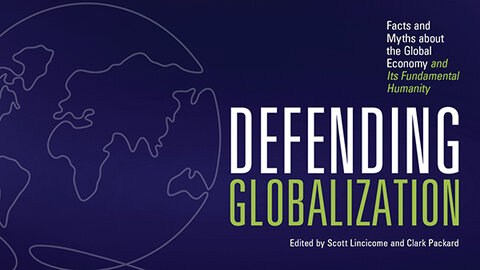
The recent Supreme Court case about affirmative action in university admissions (SFFA v. Harvard) paralleled a broader social debate over meritocracy. Those opposed to affirmative action broadly say they are supportive of meritocracy. They believe individual achievement should be more prominent in university admissions, at least when the government is involved in university funding. The debate over affirmative action and meritocracy intersects with the immigration debate in two ways. First, immigration restrictions are the most destructive form of affirmative action. Second, immigrants and their descendants have been essential in reducing the scope of affirmative action in the United States over the last 30 years.
Meritocrats believe that individuals should rise or fall on their achievements. Those supportive of affirmative action are more skeptical of meritocracy, at least how it exists under the current system. They argue that meritocracy is bad, a myth, unfair, or that current means of identifying merit are insufficient because systemic rules or practices hold back some people in specific racial, ethnic, or other categories.
I’m a supporter of meritocracy, but a compelling point raised by skeptics is that the design of meritocratic systems can select wildly different types of merit. In other words, there’s a principal‐agent problem whereby the most meritocratic people design methods of gauging merit that favor themselves and people like them.
This problem could be to the detriment of specific organizations relying on merit and, eventually, to the rest of society.
Hard work, fluid intelligence, crystallized intelligence, personality, luck, physical attractiveness, and other characteristics contribute to merit in different endeavors and extents. A one‐size‐fits‐all approach across all organizations doesn’t make sense and is slightly less bad in organizations in the same industry. That doesn’t mean some of the factors listed above aren’t good predictors of merit in most endeavors, some certainly are, but their relative weights are important.
For instance, the combination of characteristics that make a successful film actor differs from those required to be a successful astrophysicist, CEO, or farmer. But that’s just the supply side of merit; there’s also a demand side. What consumers demand of people in different endeavors changes over time. Consumers want the best over time, but what they think is best changes.
That’s why I favor the “competitive meritocracy;” that is, the meritocracy of the market over alternatives like massive government examination systems that exist in other countries. Under competitive meritocracy, firms and individuals seeking to increase profits, economic efficiency, and consumer surplus under competitive market conditions are incentivized to develop means to identify meritorious individuals that deliver. Otherwise, firm profits shrink, they go bankrupt, and consumers are left unsatisfied.
One of the beneficial results of a competitive market system is the identification and use of merit. Of course, government rules and regulations reduce the effectiveness of new merit identification techniques, but the market is better at identifying and producing meritocratic identification methods than other alternatives because it best aligns incentives to do so on the supply and demand sides.
U.S. immigration restrictions are the most anti‐meritocratic policies today, and they are intended as affirmative action for native‐born Americans. Ignore the myriad ways that immigration laws disadvantage certain immigrants relative to others, such as with the per‐country quotas that make immigrants from populous countries wait longer for green cards. Just peruse nativist websites, and you’ll see many arguments about immigrants taking jobs from more Americans who are more deserving because of where they were born. When people think of anti‐meritocratic policies, they rightly jump to quotas, race‐based affirmative action, or class‐based affirmative action.
It’s true; those are all anti‐meritocratic and likely wouldn’t exist in a free market outside of a handful of organizations in the non‐profit sector. But U.S. immigration restrictions are worse. The U.S. population is about 4.2 percent of the global population. Immigration laws prevent the other 95.8 percent of the world from trying their hand in the U.S. market meritocracy. The cost of immigration restrictions is in the trillions of dollars, which makes the real costs of affirmative action seem small by comparison. Those who truly favor meritocracy and oppose affirmative action on principle should reject the anti‐meritocratic affirmative action of American immigration laws.
Nativists agree with my analysis. They argue that the U.S. government exists to protect Americans from market competition, so it should do so with immigration restrictions. Nationalist affirmative action is still affirmative action. And lest you accuse me of hypocrisy, of working behind the protection of immigration restrictions while others labor exposed to the brutality of globalist labor competition, the sector of the economy where I labor is more exposed to legal immigrant competition than yours is.
One of the main arguments for immigration restrictions is to protect Americans. That makes sense when protecting Americans from criminals, terrorists, national security threats, or those with severe contagious diseases, because they could physically harm Americans or their property. It makes sense in the same way that the NYPD exists to protect the life, liberty, and private property of New Yorkers and shouldn’t be enforcing laws in North Dakota.
But protecting jobs and wages or shielding people from the market doesn’t make sense. On a purely principled opposition to preferences, meritocrats should oppose almost all immigration restrictions regardless of the wage effects. Immigration restrictions don’t even work well to protect American workers. Ironically, immigration restrictions do more to protect the wages of immigrant workers in the United States than native‐born workers. Affirmative action likely helps the beneficiaries more than immigration restrictions help American workers.
The idea of shielding Americans from market competition to protect them under the theory that that would make them better is silly. Industries protected behind tariffs and trade barriers tend to stagnate because they have no incentive to innovate or improve. Why would they when the government removes competition by legal fiat? Americans similarly shielded from immigration have less of a reason to get more skills, improve their human capital, or be more productive. As I wrote in my review of Reihan Salam’s Melting Pot or Civil War?, labor protectionism incentivizes stagnation among American workers.
Salam fails to draw additional connections between wages and education. He worries about low levels of educational attainment among the descendants of immigrants but also favors restricting low‐skilled immigration to raise the wages of high school dropouts. He does not explain how raising the wages for dropouts relative to other educational cohorts will incentivize workers to spend more time in school (hint: it won’t). Salam is worried that automation will destroy lots of jobs, so he wants to stop low‐skilled immigration by raising wages for low‐skilled Americans and immigrants already here, which will just make it more likely that their jobs will be automated.
Maybe you favor meritocracy in university admissions and affirmative action through immigration restrictions. You wouldn’t be the first person to have inconsistent policy opinions, but you support less meritocracy than you probably believe. Most people recognize that Texas’ “Top 10 Percent Law” is thinly disguised affirmative action because it guarantees admission to the University of Texas to all students in the top 10 percent of their high school graduating class. Since students are geographically clustered in Texas by race, this law advantages some students based on race who otherwise wouldn’t be admitted.
Harvard tried something similar when it adopted an admissions policy that accepted top‐ranking students nationwide under geographic quotas rather than relying on admissions exam scores. The intent was to reduce Harvard’s Jewish population. The Harvard freshman class was 21 percent Jewish in 1922, up from about 7 percent in 1900. Harvard’s President Abbott Lawrence Lowell wanted to bring their percentage down to 15 percent and faced fierce opposition from Jewish students, the Boston press, and the meritocrats of his day. The geographic distribution system discriminated against Jewish students and reduced their numbers to 15 percent of the student body by 1931. Harvard later eased the geographic system and then ended it altogether. One should view the admissions policy as anti‐Semitic, and the effect was identical to a policy that favored the admission of other groups like white Protestants. Regardless, the geographic admissions system was anti‐meritocratic.
Despite restrictions on immigration, immigrants and their descendants are already indirectly improving meritocracy in the United States. Edward Blum, the attorney behind numerous challenges to affirmative action, including SFFA v. Harvard, lost a challenge to affirmative action in 2015 when he had a white female plaintiff. There are many reasons why that challenge failed, but afterward, Blum said, “I needed Asian plaintiffs.” Law and the Constitution always matter to the Court, but politics and optics also matter for major controversial questions. When the issues are controversial and Congress or the President don’t want to resolve conflicts or are otherwise at loggerheads, the Court steps in as a sort of super‐legislature to decide the issue. Sometimes they rule to maintain their own institutional power in an environment where the power of Congress is declining, and that of the Presidency is increasing. Viewing the Court as a sometimes‐super‐legislature makes it clear that political narratives, public opinion, and other normal tools of political persuasion are important to ruling in a certain way. Without Asian American plaintiffs, it’s hard to see how SCOTUS would have struck down affirmative action this time. It may have happened eventually because the arguments are good, but sympathetic plaintiffs and damning facts are just as important.
Beyond the plaintiffs in SFFA v. Harvard, immigrants, their descendants, and the diversity they bring to the United States have greatly helped reduce affirmative action through politics. As I wrote in 2022:
Voters in California—the most diverse state and the one with the highest immigrant share of the population—first voted to ban affirmative action when presented with Proposition 209 in 1996. Since then, progressives in the state have attempted to revive the issue. But in 2011, Governor Jerry Brown vetoed a bill that would have weakened the affirmative‐action ban. Another proposal to re‐institute affirmative action failed in 2014 after several Asian‐American state senators defected from the effort in response to opposition from their constituents. “As lifelong advocates for the Asian‐American and other communities,” Democratic state senators Ted Lieu, Carol Liu, and Leland Yee wrote, “we would never support a policy that we believed would negatively impact our children.” In 2020, voters affirmed the state’s ban on affirmative action by a wider margin than the original vote to ban it 24 years earlier.
Asian Americans are the most likely to be foreign‐born of any racial group. In 2019, two‐thirds of Asian Americans in California were immigrants. As is clear to all after SFFA v. Harvard, Asians are the biggest losers in any race‐based affirmative action system. Without them, it would be tougher to make the case that affirmative action is unjust. That’s an unfortunate commentary on the state of political debate in the United States because the arguments against affirmative action are convincing regardless of who wins or loses, but those are the facts.
Furthermore, states with a higher foreign‐born share of the population are likelier to have banned affirmative action than states with a lower foreign‐born share. Interestingly, the share of the non‐citizen population is best correlated with a state banning affirmative action. According to a piece I coauthored a few years ago, a 1 percent increase in the share of non‐citizens is associated with a 27–34 percent increase in the probability of the state banning affirmative action. The share of the white population is not statistically significant in any regression we ran, and the measure of population‐wide diversity is only significant at the 10 percent level in the 3‑and‐5‐year lags.
Affirmative action is more politically stable when they are two groups, one of which is large and the other that is small. Malaysia has a Chinese minority punished by affirmative action and a Malaysian majority aided. Apartheid South Africa punished blacks and favored whites, which was then reversed after the end of apartheid. The United States, with blacks favored and whites punished before large waves of immigrants in the late 20th and early 21st centuries, are such cases.
Of the above examples, only the United States has a substantial immigrant‐induced demographic change that upended that relatively stable institutional dynamic by adding mainly Asian and Hispanic immigrants. Suddenly, Asians became the biggest losers of affirmative action, whites the second biggest, and Hispanics moderate beneficiaries. The goals of affirmative action became murkier – why would the U.S. government help Hispanic immigrants and their descendants with a program designed to help the descendants of black slaves?
Even more so, competition between disadvantaged groups seeking affirmative action lessened the benefits. Worse for the supporters of affirmative action, the biggest victims became a large and growing immigrant group and their children, a group whose ancestors were also targeted by racist laws like the Chinese Exclusion Act of 1882, various Alien Land Laws that barred Asians from owning land, and Japanese Internment.
There are three significant motivations for supporting redistribution, of which affirmative action is a type. They are self‐interest, compassion, and malicious envy. Self‐interest and compassion are obvious. Malicious envy is hatred toward a group that has done better. Immigration weakens all three supports for affirmative action. Immigration weakens self‐interest by spreading the benefits among more groups, it weakens compassion because new beneficiaries have dubious claims to racial preferences under the justifications for the schemes, and malicious envy is weakened because the biggest victims are no longer whites.
Immigrants weakened affirmative action in the United States by being the specific plaintiffs in SFFA v. Harvard and changing the politics of the issue. But a far more substantial and destructive apparatus of affirmative action operates today through our immigration laws that bar about 96 percent of the world’s population from participating in the American market meritocracy. Opponents of affirmative action should rest on their laurels by embracing just a touch more meritocracy just among Americans; they should embrace a true global meritocracy.



















